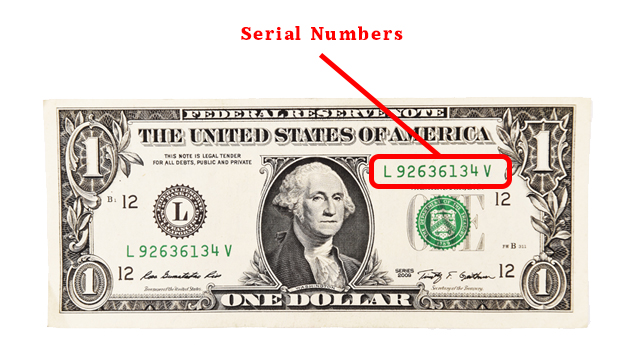How To Check Us Dollar Serial Number

Graphic by Chloe Effron 1.THE NOTE-POSITION IDENTIFIERMade up of the check letter and quadrant number, the indicates the physical spot that a particular bill occupied on a printing sheet. FEDERAL RESERVE SEALEstablished in 1913, the Federal Reserve is made up of twelve banks that distribute currency. The seal bears the name of the issuing bank and a letter designating the district—'L' is the letter for.
SERIAL NUMBERThe serial number appears twice on the front of the bill, once in the lower left hand corner and once in upper right hand corner. All bills above $2 have a serial number that begins with: The first corresponds to the, and the second to the letter code of the bank that distributed the bill ($1 bills only have this letter). The numbers that follow are simply a counter keeping track of how many of that type of bill have been printed during the series at that particular Federal Reserve Bank.
A single printing “run” exhausts the eight-digit count. After the numeric sequence, a final letter serves as part of the printing counter and is sometimes replaced by a star, which meant that there was an error in printing.
The engine serial number is the complete number shown. This is made up of. The list number or build list, typically 2 to 4 letters followed by 4 or 5 numbers. A letter identifying the country. A series of numbers showing the build line, also called a serial number. A letter indicating the year of manufacture. Cashiers, can identify a lower-quality fake bill instantly just by touching it. You may not have. This ink, especially if you are holding a new dollar bill. Suspicious bills, see if the serial numbers are the same on both bills.
A star sheet is used to replace the imperfect sheet. FEDERAL RESERVE DISTRICT NUMBERThis number appears four times on the front of the bill. These many signifiers can be helpful in cases of. FACE PLATE NUMBERThis helps to provide information about the printing plate used to create the note. Notes printed in the Forth Worth facility have an FW facility mark in front of the check letter and face plate number combination. A note that was printed on a can be identified by the lack of plate location or check number, and by the plate number on the back being located at the top of the letter E in the word ONE.
SIGNATURE OF THE SECRETARY OF THE TREASURYCurrent Secretary of the Treasury is the 76th person (all men) to hold the position. SERIES YEARContrary to popular belief, the series year that the bill was printed, but the year that the series began. A new series comes from a change in the Secretary of the Treasury, the Treasurer of the United States, a significant gap in production times, and/or a change to the note's appearance. SIGNATURE OF THE TREASURER OF THE UNITED STATESCurrent Treasurer Rosa Gumataotao Rios is the 43rd person to hold the position, which has been held.
Graphic by Chloe Effron 9. MOTTO'In God We Trust' is the national motto of the United States and first appeared on paper currency in, after a piece of made it mandatory on all bills and coins. The motto was originally placed on coins due to increased religious sentiment during the Civil War. Secretary of the Treasury Salmon P. Chase received many appeals and instructed James Pollock, Director of the Mint at Philadelphia, to prepare a motto. It first appeared on the 1864 two-cent coin. BACK PLATE NUMBERSimilar to the front plate number, the back plate number identifies the specific printing plate used to print the reverse side of the bill.

THE GREAT SEALThe Great Seal appeared on the $1 bill in, and we can thank President Franklin Roosevelt for one of the lasting design features. When it was first submitted for his approval, the obverse and reverse were swapped. Download age of empires 2 conquerors full. Roosevelt rescinded his initial approval, made some changes (including the seal switch) and initialed 'FDR.'